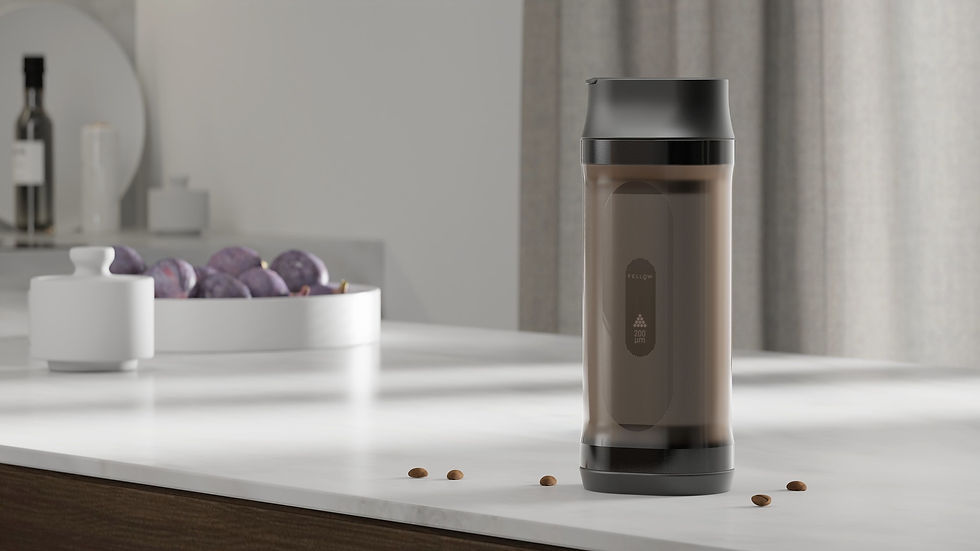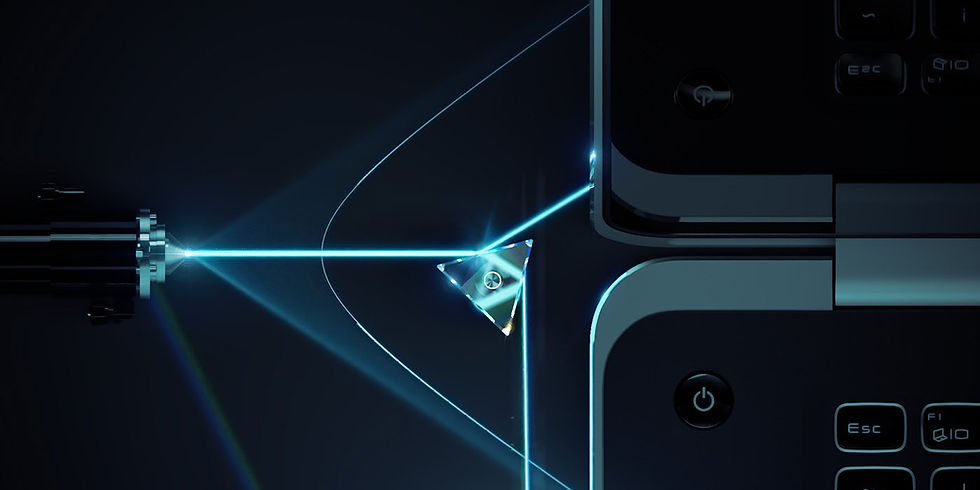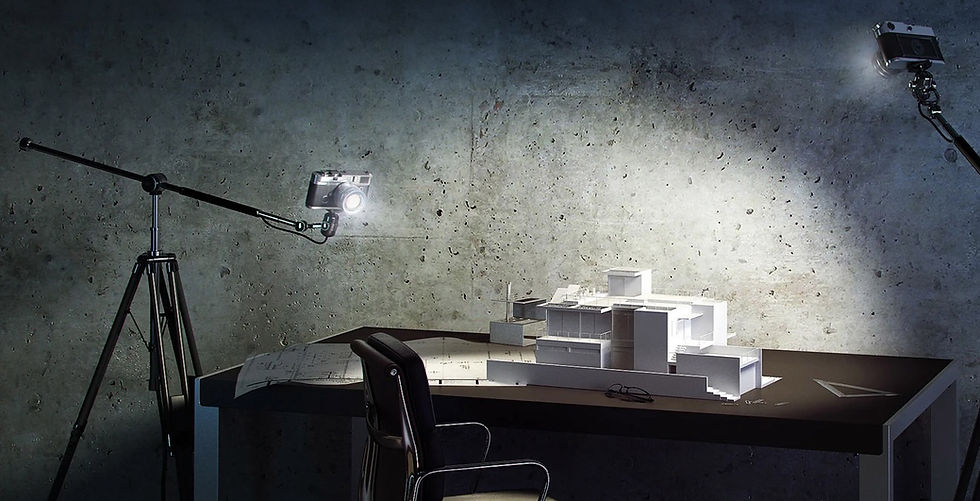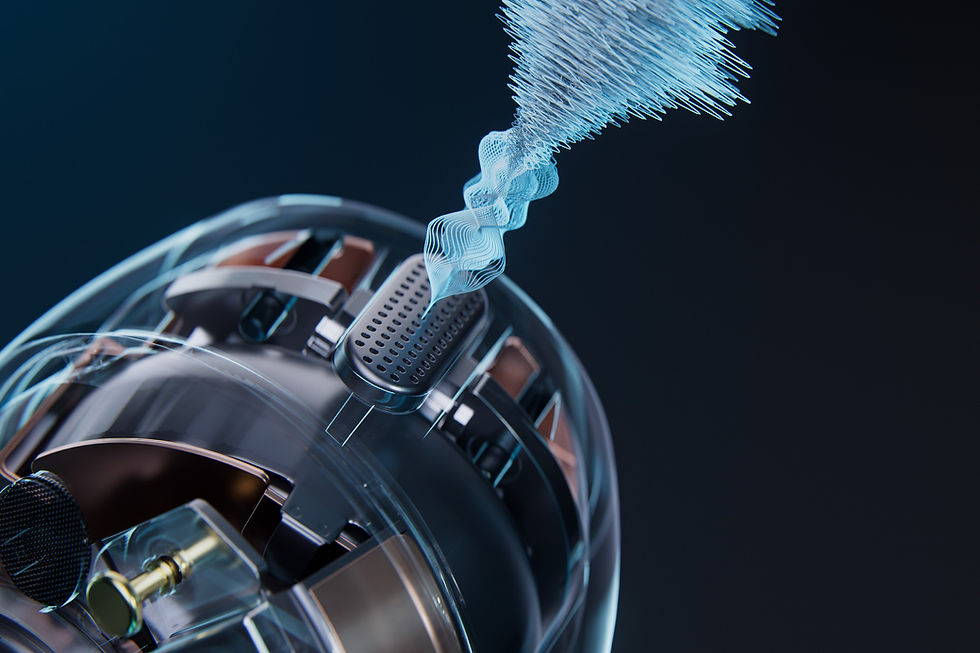What Is Photorealistic 3D Product Rendering?
- Ilya Samokhvalov

- Aug 10
- 11 min read
Updated: Aug 11
Photorealistic 3D product rendering is a cutting-edge technique for creating lifelike images of products entirely on the computer. In simple terms, artists build a virtual 3D model of a product and then produce a rendered image that looks just like a real photograph of that product. The goal is for someone to look at the image and not realize it was made with software – every detail, material, and lighting effect appears as it would in a real-life photo.
Table of Contents

This means the textures (like wood grain or fabric weave), the way light and shadows fall, and even reflections on shiny surfaces are all simulated with such realism that the line between CGI and reality blurs. Companies use photorealistic renderings in place of traditional photos for e-commerce, catalogs, marketing, and more, because the quality has become virtually indistinguishable from high-resolution photography.
How does photorealistic 3d rendering work?
Creating a photorealistic 3D render is somewhat like conducting a virtual photoshoot, except everything is digital. Here’s a high-level look at how it works:
3D Modeling: First, a detailed 3D model of the product is created using specialized software. This is a digital replica of the product’s shape and design. Skilled 3D artists use reference photos, drawings, or CAD files to ensure the model’s geometry is accurate to the real thing. If the product doesn’t exist yet, the model can be built from design specs or even conceptual sketches.
Materials and Texturing: Once the 3D shape is ready, the artist applies materials and textures to it. This step is like “digital painting” – the software wraps the model in surface details that mimic real materials. For example, they’ll make the plastic parts look smooth or give metal parts a realistic shine. Every tiny detail, from clear reflections on a polished metal to the weave of fabric, can be recreated with great accuracy. High-resolution texture maps and shaders define how the product’s surfaces respond to light – whether they’re glossy, matte, transparent, rough, etc.
Lighting and Environment: Next comes setting up virtual lighting and cameras. Just as in a photography studio, the 3D artist places light sources around the scene. These could simulate anything from soft indoor lighting to bright sunlight. Advanced rendering software uses physics-based lighting (techniques like ray tracing) to calculate how light rays would bounce off the product’s surfaces, creating realistic highlights, shadows, and reflections. The artist also chooses a background or environment – it could be a simple white backdrop (common for product images), a virtual room scene, or an outdoor setting, depending on the desired context.
Rendering (Image Generation): Finally, the scene is "rendered" – the computer crunches the data to produce the final 2D image. This can be a time-consuming process where the software calculates all the lighting interactions and fine details to output a high-quality image. The result is a photorealistic image of the product from the virtual camera’s perspective. If multiple angles or animations are needed, the artist can move the camera or animate the model and render again. Achieving true photorealism requires finesse – often a bit of tweaking and re-rendering happens to get things just right, much like a photographer taking several shots to nail the perfect look.
It’s worth noting that skill and experience play a big role in this process. The technology is powerful, but it typically takes a trained 3D artist to fine-tune the model, materials, and lighting to achieve a photographic level of quality. Modern 3D software (such as 3ds Max, Maya, Cinema 4D, Blender, etc.) and rendering engines (like V-Ray, Arnold, or Octane) provide the tools, but it’s the artist’s understanding of real-world physics and aesthetics that brings a render to life. When done right, the end product is so realistic that even experts may have a hard time telling if an image is a render or a photograph.

Benefits of photorealistic 3d product rendering
Photorealistic 3D rendering isn’t just an attractive way to present products – it also offers practical advantages over traditional product photography and other visualization methods. Here are some key benefits:
Unmatched realism and detail: As the name implies, photorealistic rendering delivers hyper-realistic detail. Every stitch on a piece of furniture or the fine grain of wood can be shown with precision. The product is depicted in the best possible light, with accurate colors, textures, and scale. This level of detail helps customers truly understand the product’s quality up close, building confidence that “what you see is what you get”.
Creative freedom and flexibility: With 3D rendering, imagination is the limit. You can showcase the product from any angle or in any setting without needing a physical prototype or location shoot. Want the product against a clean white background, a luxurious living room, or floating in an abstract environment? It’s all achievable digitally. You can easily create multiple variations of an image – e.g. change the product’s color or finish – with just a few clicks, rather than organizing new photoshoots for each variation. This flexibility extends to making quick edits: if you need to tweak a design or try a different lighting mood, you can adjust the 3D scene and re-render, rather than starting over from scratch.
Cost and time savings: Photorealistic CGI often saves money and time compared to traditional photography. Think about the logistics of a pro photoshoot: building prototypes, renting studio space or locations, hiring photographers and crew, setting up lighting, etc. – it gets expensive and time-intensive. With 3D rendering, many of these costs vanish: there’s no need for physical prototypes or elaborate sets, and no shipping products around for photo sessions Once a detailed 3D model is made, it can generate as many images as needed with minimal additional cost. Companies can get high-quality visuals on tighter budgets and timelines. It’s also easier to avoid mistakes – for example, if a design changes last-minute, you don’t have to redo a whole photo shoot; the 3D model can simply be updated and re-rendered. This agility means faster turnaround and the ability to meet marketing deadlines without rushing physical production.
Pre-visualization and marketing before manufacturing: 3D rendering allows teams to visualize a product before it even exists in reality. This is hugely beneficial for product development and marketing. Designers can see realistic previews of their concepts and catch issues early. Marketers can start advertising with photorealistic images long before the first unit is manufactured. For startups or product launches, this means you can gauge customer interest and even take pre-orders using CGI images, reducing the risk and cost of producing prototypes upfront. It essentially brings products to market faster by bridging the gap between idea and reality.
Consistency and control: Because everything is generated in software, brands have full control over consistency and style across all images. You can ensure every product shot has the same lighting and quality, which is great for a consistent catalog or website look. Also, 3D renders are not subject to real-world constraints like weather or studio availability – you can “shoot” a summer scene in the dead of winter, or create a perfect sunset lighting for every image. The digital environment means no surprises: you get exactly the shot you envisioned, because you can adjust every element in the scene.
Interactive and engaging content: Once a product is rendered in 3D, those same assets can be used to create interactive experiences that traditional photos can’t match. For instance, you can generate 360-degree product viewers, allowing customers to spin and view the item from all sides. The 3D models can also power augmented reality (AR) applications, so users can project the product into their own living space via a smartphone (imagine seeing a virtual piece of furniture in your room before buying it). Additionally, you can easily produce animated clips (e.g. an exploded view showing the product’s internals, or a short promo video) using the 3D model. This modern, interactive content is increasingly important for e-commerce and tech-savvy consumers. It keeps audiences engaged and can set a brand apart with a high-tech presentation.
All these benefits explain why photorealistic 3D rendering is transforming how companies showcase products. In many cases, businesses are now shifting from traditional photography to CGI because it offers more versatility and efficiency. A well-executed render can achieve the same impact as a photograph (sometimes even exceeding it in visual appeal), without many of the limitations of physical shoots. In fact, many major retailers and brands today use CGI images in their product catalogs and websites – chances are you’ve been looking at 3D renders while shopping online and didn’t even realize it!

Common uses and applications
Photorealistic 3D product renderings are used across a wide range of industries and scenarios. Anywhere a product needs to be visualized realistically, CGI can play a role. Here are some of the most common applications:
E-Commerce & retail: Online retailers use photorealistic renders to display products on their websites and apps. High-quality 3D images show customers exactly what they’re buying, with the ability to view products in multiple colors or configurations without photographing each one. Some stores offer 360° rotate-and-zoom views or AR try-outs (e.g. see a 3D sofa in your living room via your phone) to enhance the shopping experience. Because renders are so lifelike, they can replace traditional product photos while providing more options for interaction.
Product catalogs & marketing materials: Manufacturers and brands produce entire catalogs and brochures using CGI imagery. From consumer electronics to furniture, photorealistic renders are used in place of expensive photoshoots for ads, posters, billboards, and social media content. Marketers love the eye-catching, perfect visuals that CGI delivers. Plus, it’s easy to create marketing visuals before a product is even made – great for building hype during pre-launch campaigns.
Design & prototyping: Engineers and product designers employ 3D renderings to evaluate and share designs internally or with stakeholders. Virtual prototypes can be rendered to look real, which helps in spotting design improvements and getting feedback without manufacturing a physical prototype. This is common in industries like automotive and industrial design – for example, a company might render a new tool or a car part to see how it looks and functions, or to demonstrate it to investors and focus groups. It’s a cost-effective way to test and communicate ideas.
Architecture & interior design: While this crosses into architectural visualization, it’s worth mentioning that photorealistic product rendering is crucial for interior design and furniture companies. A furniture maker, for instance, can render their new sofa or lamp in a variety of room settings to show how it would appear in a styled environment. Interior designers use product renders to populate their room visualizations with real furniture pieces, achieving completely lifelike interior images for clients. This helps designers and buyers alike to visualize how products fit into a space without physically staging anything.
Advertising & entertainment: In the world of advertising, CGI product renders are used to create splashy visuals that might be impractical with physical shoots. For example, an electronics brand could produce a dramatic exploded-view graphic showing all the components of a gadget flying apart in mid-air – a scene nearly impossible to photograph but easy to do with 3D. Television commercials and product demonstration videos also use photorealistic 3D renders (sometimes alongside real footage) to achieve effects or angles that cameras can’t. The result is often more engaging storytelling and visuals that attract customers.
Augmented reality (AR) & virtual showrooms: As mentioned, the same photorealistic 3D models can be used in AR applications or virtual reality showrooms. Car companies, for example, use AR to let users place a virtual car in their driveway at real scale. Furniture retailers have AR apps to visualize furniture in your home. These experiences require high-quality 3D models of the products. Photorealistic rendering ensures that when the product is viewed in AR or VR, it looks convincing and true-to-life. This application is growing, as it offers an interactive way for customers to engage with products remotely.
In summary, photorealistic 3D rendering is now a standard practice in industries ranging from consumer goods and fashion to automotive, furniture, and tech. It provides a level of versatility and visual power that traditional imagery can’t easily match, which is why more and more businesses are integrating CGI into their product development and marketing workflows. Brands can elevate their digital presence, streamline content creation, and deliver jaw-dropping visuals that drive engagement and sales.
FAQ
What is photorealistic 3d product rendering?
It’s the process of creating highly realistic images of a product using 3D modeling and computer rendering, instead of photography. A digital 3D model of the product is made, then materials, lighting, and cameras are applied in software to generate an image that looks just like a real photo of the product. In short, it means producing a fake photo that’s so realistic, viewers often can’t tell it’s computer-generated.
Can photorealistic CGI really replace traditional product photography in quality?
Yes. With today’s advanced software and skilled artists, a well-executed 3D render can achieve quality on par with high-end photography – sometimes even surpassing it in visual appeal. The textures, colors, and details in a photorealistic render are accurate enough that customers usually cannot tell it’s not a photograph. In fact, many large retailers already use mostly CGI images in their catalogs and websites because the results are so realistic and easier to produce at scale.
What are the advantages of 3d rendering over traditional product photography?
There are several major advantages. Cost and efficiency is one: CGI eliminates the need for physical prototypes, studio space, and large photoshoot crews, which saves a lot of money and time. Another big advantage is flexibility: you can create unlimited backgrounds, angles, and product variations digitally without new photoshoots – for example, easily change a product’s color or setting in software. There’s also the speed of updates – if you modify the product design, you can update the 3D model and re-render quickly, instead of scheduling a whole new shoot. Finally, 3D renders open up interactive possibilities (like 360° viewers or AR apps) that standard photos can’t support as easily. In short, 3D rendering offers more creative control and reusability, often at a lower long-term cost.
How long does it take to create a photorealistic 3d product render?
The timeline can vary depending on the product’s complexity and the number of images needed. Generally, creating a single high-quality product render might take anywhere from a few days up to a couple of weeks. Most of that time is spent on building and refining the 3D model and textures, which is the most labor-intensive part. Once the 3D model is ready, setting up lighting and rendering the image is relatively quick – additional views or angles can be generated faster because the heavy work (making the model) is already done.
Compared to organizing a photoshoot (which could take weeks of planning), a CGI project is often faster overall. For example, a studio might deliver draft renders within a week for feedback, and final images after revisions shortly thereafter. Tight deadlines can sometimes be accommodated as well, since an all-digital workflow is quite agile.
Do I need a physical prototype or CAD files to have my product rendered?
Not necessarily, but providing reference materials helps. If you have CAD models or engineering drawings, those are ideal – they give the 3D artist exact dimensions and details of the design. However, photorealistic renders can also be created from good photographs of an existing product or even hand-drawn sketches, as long as key measurements and details are known.
The more info you supply (product dimensions, material samples or descriptions, reference photos of textures, etc.), the more accurate the result will be. In many cases, clients provide whatever they have – from 3D files to rough sketches – and the rendering team will build a precise digital model from that. You don’t absolutely need a physical prototype on hand; a skilled 3D artist can virtually recreate the product using design specifications and reference images.
Is photorealistic product rendering affordable for small businesses?
Yes. This technology is no longer only for big-budget brands – it’s increasingly accessible to businesses of all sizes. In fact, small companies can often gain even more by using CGI, because it lets them produce high-quality images without the expense of traditional photoshoots. Instead of renting studios and producing multiple prototypes, a small business might invest in a few good 3D models and then get a whole library of product images from them.
The cost of 3D rendering services has become quite flexible and scalable: you can start with just a couple of key product renders, or do an entire catalog, depending on your budget. Plus, the ability to market products before manufacturing (using renders) can help a startup test the market and gather interest without huge upfront costs. Many 3D visualization studios work with startups and small firms, tailoring their services to fit the client’s needs and budget.
Can 3d product renders be used for animations or AR/VR applications?
Absolutely. Once a product is modeled in 3D, the digital asset is very versatile. The same 3D model can be used to create product animations – for example, a 360° rotating view, an exploded view showing the product’s components, or a full video demonstrating features. Likewise, photorealistic 3D models can be imported into augmented reality (AR) apps or virtual reality environments. This means a customer could use their phone to see a rendered product in their own room at scale, or interact with it in a VR showroom.
These interactive experiences are a big advantage of CGI, since traditional photos are static. Many companies are now leveraging this by providing AR model view options for shoppers or interactive 3D configurators on their websites, all built on the back of photorealistic 3D renderings. In summary, once you have a photorealistic 3D render/model, you can reuse it in many modern, interactive ways to engage customers.














